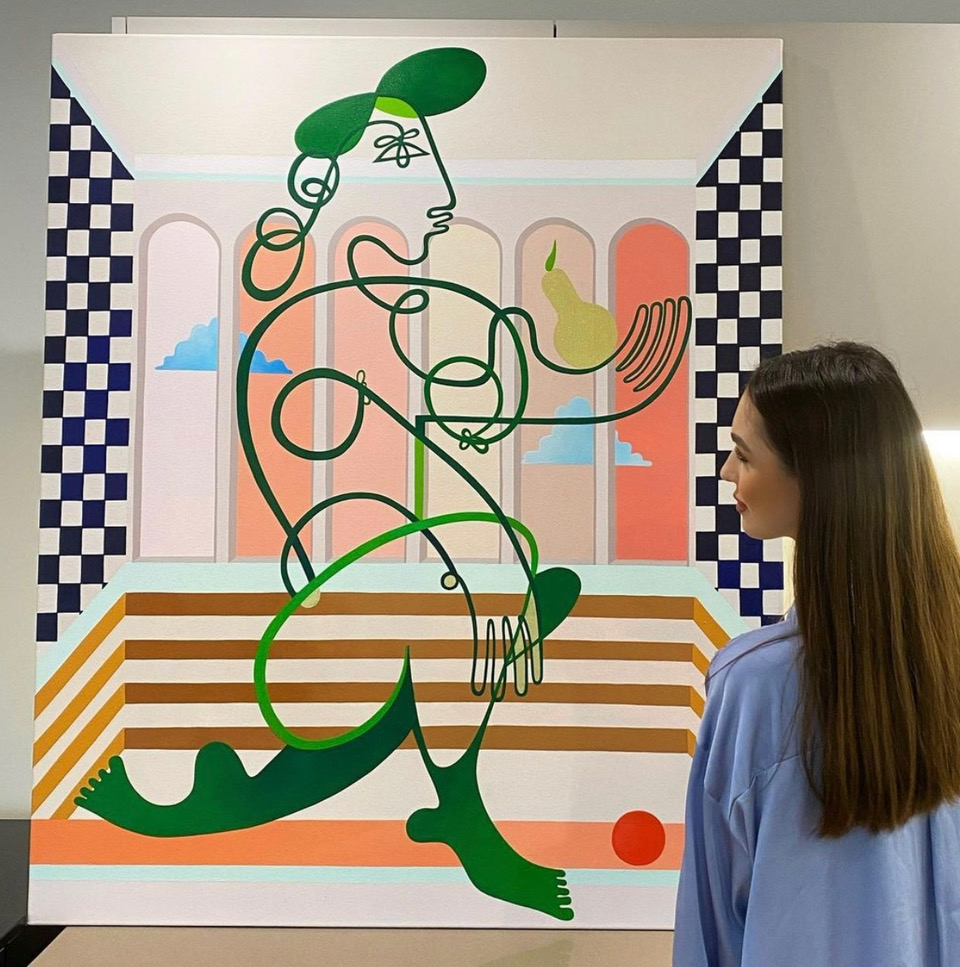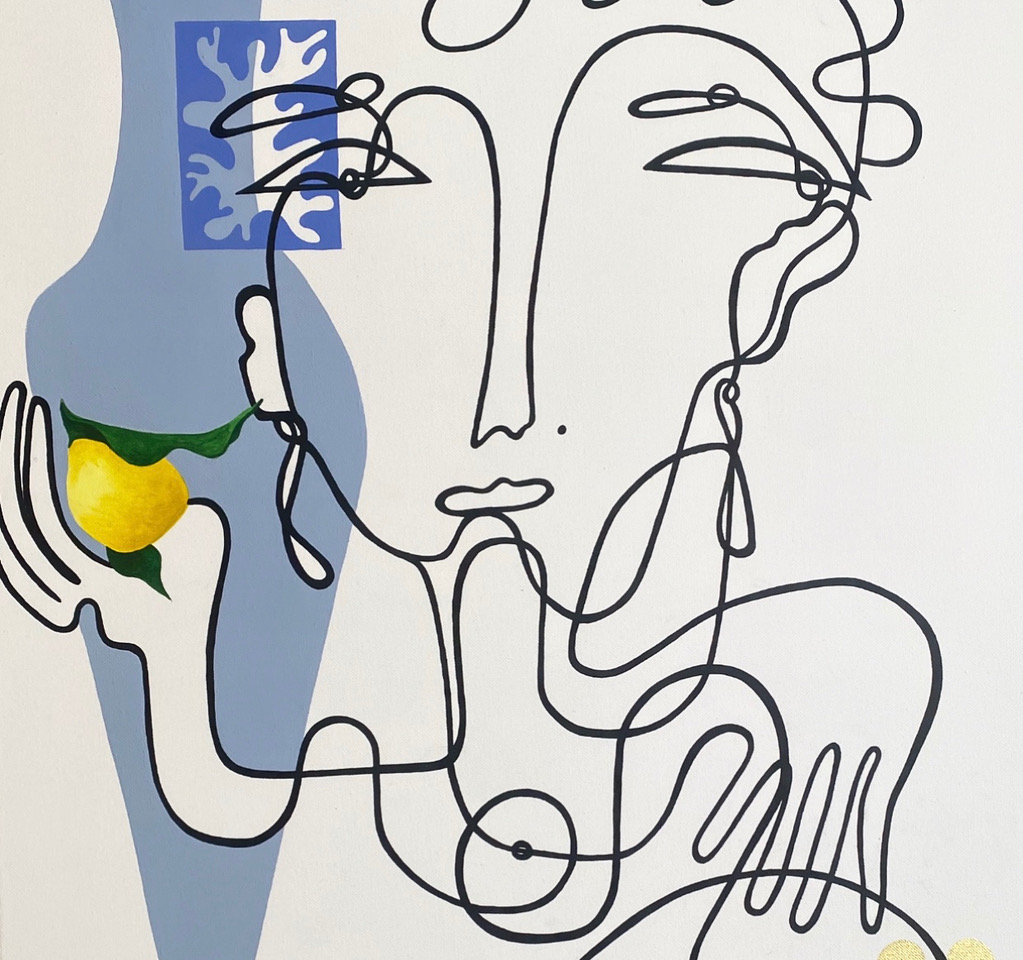
During a week that kicked off with International Women’s Day celebrating women all around the world, Lee Sharrock talks to upcoming artist and interior designer Celine Ali about ‘In her eyes’, a new exhibition celebrating women in art, the male gaze, and her hopes for a future where we are no longer bound to gender binaries. Celine quotes G. D. Anderson, whose words seem strikingly pertinent at this time in history: “Feminism isn’t about making women stronger. Women are already strong. It’s about changing the way the world perceives that strength.”
Lee Sharrock: Can you tell me a bit about yourself, where you were born, where you live and work now, and how you started out on the path you’re on now as an artist?
Celine Ali: My cultural background is quite mixed as I was born and raised in Romania, but I am of Turkish ethnicity. I’ve been interested in art from a young age, and art has shaped my perspective and enabled me to explore different visual interpretations. I’m most proud of my work being featured in international exhibitions including; ‘Leonardo Award, Young Artist’ at ‘Biennale of Chianciano’ (Italy); ‘Autumn Exhibition’ at ‘Real Academia de Bellas Artes de Santa Isabel de Hungria Sevilla’ (Spain); and ‘Ethics DNA of Art’ at ‘The New Florence Biennale’ (Italy).
I am currently living in London and doing my Masters degree in Fine Art at London Metropolitan University, whilst working on commissions and preparing my solo exhibition.
What medium and materials do you use for your paintings?
The use of colour is really rooted in my instinct, so I always like to incorporate a bold use of colour and vibrancy in my artwork. I use primarily acrylics to apply my ethereal abstractions on linen canvases.

Your paintings are a mix of figurative and abstraction. Is your starting point for each painting usually a person or an emotion?
My current artwork is strongly influenced by the complex relationship between humans and the surrounding world, and I capture these emotions and thoughts through a pure single-line drawing with a dreamy and surreal aesthetic. A lot of my paintings are based on human connectivity, so the single and continuous line in my artworks is a metaphor for the line that connects us. A main concept that I approach in my artworks is the “Eternal Feminine”, which focuses on the polychrome and multiform universe of femininity. In my practice, I explore the definition of femininity in its immutable essence, the idea of femininity as a reflection of divinity, a spiritual love that crosses the boundaries of time, a source of purification and elevation, and a force of the universe that forms everything and holds everything.
I am fascinated by emotions and I access my darkest inner feelings to explore them. Hence, my art embodies a feminist approach through a creative and spiritual journey, through abstraction and emotions, vulnerability and strength. Randomness and spontaneousness are key principles that drive my artistic journey, this emotional process moves intuitively revealing organic lines, bold and colourful shapes, and brushstrokes evoking a vibrant and powerful expression.
Who are your inspirations and how do your painting and interior design compliment/ interact with each other?
I get inspiration from random and quotidian things like a song or just a simple walk in nature, as well as from influential artists like; Henri Matisse, Picasso, Tracey Emin and Louise Bourgeois.
I am an individual who loves art and beauty in any form, so I would say that my interior design knowledge really complements my output as an artist. I always like to think of my artworks in relation with the space they’re going to be part of.

What effect did the pandemic and lockdown have on your artistic practice, did it make you more prolific and creative or inhibit your creativity?
The Pandemic has proved itself as having a more positive effect on my art practice rather than a negative impact: because of the lockdowns, I had a chance to isolate with my thoughts and express my reflections through my art pieces. In normal circumstances I never had enough time to reflect without being distracted by other people or activities.
Surprisingly, as a lot of people work from home now and spend more time indoors, everyone wanted to re-design and transform their place in a calm and cosy place, so luckily I had a lot of commissioned artworks.
Your work is featured in ‘Through her eyes’, an exhibition celebrating women in art launching this week to coincide with International Women’s Day. What does IWD mean to you and would you call yourself a feminist, or do you think feminism has a different meaning for your generation?
Feminism is such a complex and multifarious concept, and there are so many waves of feminism that it should be a plural world. I’d like to admit that I still have a lot to learn about the history of the feminist movement and what it means to be a feminist. However, I still believe with confidence that I am a feminist, but in a natural and peaceful way. Feminism in my generation has a very strong and interesting voice in the way that we express femininity, which merged in different forms of expression such as; motherhood, nudity, sexuality to even bisexuality and many other angles.
There is also a remarkable desire of the new generation of artists to accept feminism as a valid and current subject, which still strives to adapt the work of the last seventy years to address the crucial issues and tough conversations that are emerging today.
In my opinion, feminism isn’t about women hating men and leaving all other identities out – it’s about equality for all people, empathy, love and treating all people with respect. Based on my definition of feminism, I would hope people who have a negative view of feminists have learned something, and maybe next time they meet one, they will respect them and have an open mind. I’m proud to identify myself as a feminist.
I’d like to share a quote which resonates with me: “Feminism isn’t about making women stronger. Women are already strong. It’s about changing the way the world perceives that strength” G. D. Anderson
Feminist artist collective the Guerilla Girls released a book in 2020 titled Guerrilla Girls: The Art Of Behaving Badly, which features over 200 artworks by the group who produced thousands of feminist posters with discrimination statistics since they formed in 1984. They said in an interview with The Guardian that their book was an attempt “to rewrite an art history that has erased female artists, as well as people of colour, many of whom have been left outside of the art world canon – especially when it comes to museums.” Guerilla Girls formed in 1984 when they protested outside the Museum of Modern Art in NYC which was showing ‘An International Survey of Recent Painting and Sculpture’. The exhibition featured 165 artists of which 152 were male and only 13 were women. But representation of women artists in museum collections hasn’t improved that much in the 35 years since Guerilla Girls formed: in a New York Times report in September 2019, only 11% of art acquired by America’s top museums between 2008 and 2018 was by female artists. And only one woman (Jenny Saville) features in an artprice.com list of the top 10 Contemporary Artworks sold at auction between July 2018 – June 2019. How do you feel as a young female artist coming up now – do you ever feel like you have to work harder or shout louder to make a name for yourself in the art world because of your gender, or do you feel that gender isn’t so much of an issue for a Generation Z artist?
Women have been discriminated against for centuries, and major arts institutions have typically failed to support the careers of women artists working on the margins. Despite clear evidence of gender discrimination against women in the arts, I don’t feel discouraged at all, rather I feel privileged that I can express my feminine voice more loudly through my artworks, and feel that it’s my duty to be a voice of change. I think the upcoming generations digest a lot of stress, anxiety and confusion as a consequence of the previous generations, however it is our right and duty to move on and adapt the old issues to fit the priorities of today.
Chimamanda Ngozi Adichie said: “A feminist is a man or woman who says, ‘Yes there’s a problem with gender as it is today, and we must fix it. We must do better’.” I think society today is plagued with gender inequality, and it’s our mission as the next generation to take action and challenge the status quo. I have a strong hope that we will reach a time when the gender of the artist will no longer be relevant.
There’s a distinctly Cubist aesthetic in your paintings, with the side on, two-dimensional perspective of figures, and iconography familiar from Picasso’s paintings such as the dove. Is Picasso an influence on your work? And who is the muse featured in your paintings – is she a self-portrait?
Although, Picasso is one of my favourite artists I wouldn’t say he is a direct source of inspiration. I’ve always considered my art to be a direct extension of me: my emotions, thoughts, fears, dreams, impulses, insecurities, triumphs and so on.
However personal, my work has always upheld a social consciousness, and I strive for it to be informed not only by my own authentic visions, but in some way to function as a voice for the unheard in the society.
Talking about the imagery and symbols of my artworks, these are influenced by feminine essence: my aim as an artist is to further explore the immutable concept of the eternal feminine, and transcend traditional boundaries by encapsulating more than one single idea. What I want to reflect through my art is the representation of the complex philosophy of femininity in its essence. Through my work I explore the complex concept of ‘eternal feminine’, which was examined by the German writer Johann Wolfgang von Goethe, who described the female entity as ‘a divine manifestation, a pure form that elevates perfection, being meant to illiterate the divine and spiritual love.’
Picasso was well known for his womanising and was quite misogynistic in his treatment of them. He featured his lovers and wives in his paintings. Picasso was with Dora Maar when he had an affair with painter Francoise Gilot – he was in his 60s and she was 21 when the met and he featured her in his work famously in ‘Femme Debout’. In Gilot’s biography she talks about her work taking a back seat to Picasso’s and she eventually left him. How do you feel about the idea of the muse in art, and are you taking back control from the male gaze with your paintings by using the perspective of the female gaze?
The ‘male’ gaze seeks to devour and control, whilst the ‘female’ gaze is more a frame of mind, where the approach to subject and material is more emotional and respectful. I try to depict a particular sensitivity through my art, with an openness to experimentation, and a penchant for embracing failure and imperfections. I want my imagery to come alive, and I think perfection is boring.
Believing in a female gaze means I believe in the male gaze. I hope we’re moving towards a world not bound to gender binaries.
What projects are you working on currently?
We are still in a pandemic so there are not many real-life art exhibitions at the moment, however I am preparing for a solo exhibition and working on some commissions. Stay tuned on my instagram page: @celineali_art and website: www.celineali.art







